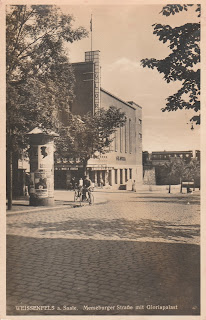18.01.2021
Gloria in Weissenfels/Germany
06.01.2021
Kino International in Berlin/Germany - "Die Perle" 1964
This is already my 25th postcard showing Kino International in Berlin (counted according to the poster motif). The postcard is extra large (21,4 cm x 10,3 cm) and was sold with an envelope. It was made by Graphokopie H. Sander K.G. Berlin and was published by Berlin Werbung Berolina.
The poster on the cinema building advertises the film Die Perle / The Pearl / La perla - a 1947 Mexican-American film directed by Emilio Fernández. It is based on the 1947 novella The Pearl by John Steinbeck, who also co-wrote the screenplay.
The film came to East German cinemas on May 26, 1964. It was shown already August 12, 1950 in the West German cinemas with the titel Mexikanische Romanze - but only 77 min of total 85 min.
In 2002, the film was selected for preservation in the United States National Film Registry by the Library of Congress as being "culturally, historically, or aesthetically significant".
The poster was designed by Horst Klöpfel.
01.01.2021
Cinema Teatro in Asmara / Eritrea
Cinema Teatro in Asmara - today Teatro Asmara - is a late eclectic historicism building in Asmara, the capital of Eritrea, and part of the UNESCO World Heritage Site Asmara: A Modernist City of Africa.
The building was designed as an opera house and was completed in 1920 according to plans by Odoardo Cavagnari (1868–1920). The design of the immediate area could no longer be completed, as the sponsoring company went bankrupt in 1924.
The as yet unused area in the vicinity of the opera house fell to the state, which sold it to investors in 1927, who built shops and a dance hall here 10 years later. The opera house itself has been converted into a cinema. Since then, there has been a café in the foyer. The building was used as a cinema until 1957.
After the federation of Eritrea and Ethiopia in 1952, under pressure from the Ethiopian viceroy, the building was sold to the state by the Italian owners at a price that was far below its value, and according to other sources, it was sold to a son-in-law of the then Ethiopian emperor, Haile Selassie.
After Eritrea gained independence in 1991/93, it was transferred to the state property of the new state. The main office of the national telephone provider Eritel is located in a side building and the actual opera house is occasionally used as a theater.
In Asmara there are still other worth seeing cinemas like Cinema Impero, Cinema Roma and Cinema Odeon.


